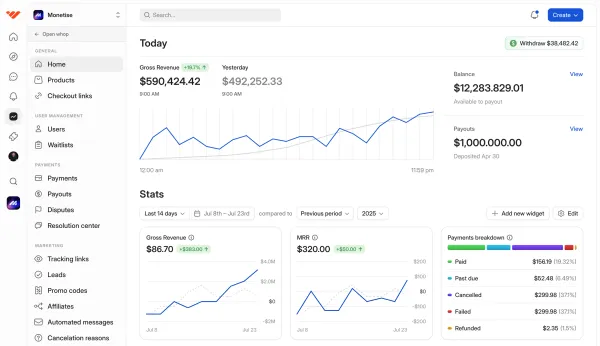Curious about the right model for your online business? Uncover the pros and cons of ecommerce and dropshipping, and find out how Whop can support your success.
Key takeaways
- Global ecommerce sales are projected to reach $6.3 trillion in 2024.
- Traditional ecommerce requires higher upfront capital but offers better profit margins.
- Dropshipping allows entrepreneurs to start with minimal investment and inventory risk.
- The dropshipping market is expected to hit $196.78 billion in 2024.
- Traditional ecommerce provides complete control over branding and product quality.
The explosion of online retail has entrepreneurs everywhere asking the same question: should I go with traditional ecommerce or try dropshipping?
With global ecommerce sales projected to reach $6.3 trillion in 2024, it's a golden time to get into online selling – but choosing the right business model is important.
Traditional ecommerce is the digital equivalent of a regular store – you buy inventory, store it, and ship it yourself.
Dropshipping is a specific method of ecommerce. You're the face of the business, but your suppliers handle the inventory and ship directly to your customers.
Confused about which model might work better for your entrepreneurial dreams and running low on time?
Here's a super quick summary.
Ecommerce and dropshipping at a glance
The traditional ecommerce business model works well for entrepreneurs with more capital who want control over their brands and products.
Dropshipping is ideal for beginners testing the waters, those with limited capital, or anyone wanting to validate product ideas quickly.
| Dropshipping | Ecommerce | |
| Less Capital Needed | ✅ | ❌ |
| Product Control | ❌ | ✅ |
| Quality Control | ❌ | ✅ |
| Profit Margins | ❌ | ✅ |
| Risk (Low) | ✅ | ❌ |
| Brand Building | ❌ | ✅ |
| Quick Market Entry | ✅ | ❌ |
| Customer Service | ❌ | ✅ |
| Scalability | Tie | Tie |
Want more details - stick around for the rest of the article where we take a deep dive into each of these factors.
A brief history of ecommerce and dropshipping
Remember when shopping meant actually leaving your house?
Ecommerce changed all that - and it's wild to think it started back in 1994 when a guy named Phil Brandenberger made history by purchasing a Sting CD online for $12.48 (yep, that was the first secure online transaction).
The real game-changer came in 1995 when Amazon and eBay burst onto the scene. What started as Amazon selling books from Jeff Bezos's garage has exploded into the everything-store we know today.
Pretty much everyone jumped on the bandwagon during the dot-com boom of the late '90s, and then things really took off when PayPal made it super easy to pay online in the early 2000s.
Then around 2010, something interesting happened.
As Chinese manufacturers started opening their doors to Western entrepreneurs through platforms like AliExpress, dropshipping became the new gold rush. Suddenly, anyone with a laptop and some marketing skills could launch an online store without touching a single product.
Shopify made it even easier by integrating with these suppliers, and social media advertising lets sellers reach customers directly. It was like the democratization of retail – no warehouse, no inventory, just pure entrepreneurial hustle.
Let's take a closer look at the ecommerce and dropshipping business models.
- Best dropshipping niches for launching winning products
- Best dropshipping products for beginners
- Profitable ecommerce business ideas to start today
What is ecommerce?
Ecommerce is the modern way of buying and selling products or services over the internet. Unlike your local corner store, an ecommerce business operates 24/7, letting customers shop whenever and wherever they want.
Running an ecommerce business means you're in charge of the whole show. You'll need to source your products, maintain inventory, set up shop with an online storefront (like Whop or WooCommerce), handle packaging, and coordinate shipping to your customers. Big players like Amazon and ASOS have mastered this model, but plenty of small businesses are crushing it too.
The real beauty of ecommerce lies in its flexibility. You can start small from your garage, selling handmade jewelry or vintage finds, or go big with a warehouse full of products.
A recent survey shows that 76% of U.S. adults shop online, making ecommerce a significant piece of the retail pie.
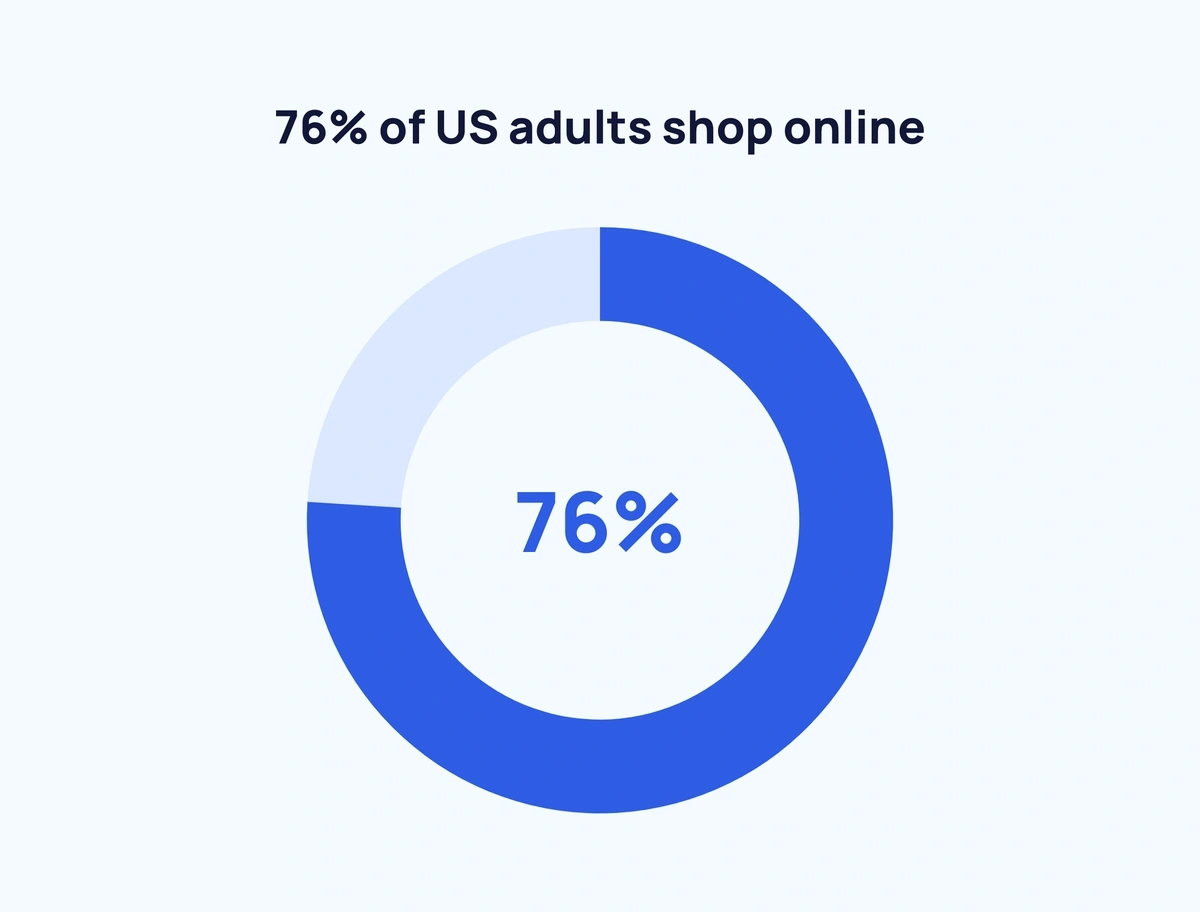
The different types of ecommerce
Let's break down the different ways people and businesses buy and sell stuff online.
Business-to-Business (B2B): Companies selling products/services to other businesses.
Example: Alibaba supplies raw materials to manufacturers. This ecommerce business model typically involves larger order volumes and longer-term contracts.
Business-to-Consumer (B2C): Businesses selling directly to end consumers
Example: Amazon selling products to individual shoppers. Usually involves single-item or small-quantity purchases.
Consumer-to-Consumer (C2C): Individuals selling products/services to other individuals.
Example: eBay facilitating person-to-person sales. A website platform typically acts as an intermediary for trust and payments.
Consumer-to-Business (C2B): Individuals offering products/services to businesses.
Example: Freelancers on Fiverr or Upwork selling services to companies. This model reverses traditional business flow, letting consumers set terms.
What is dropshipping?
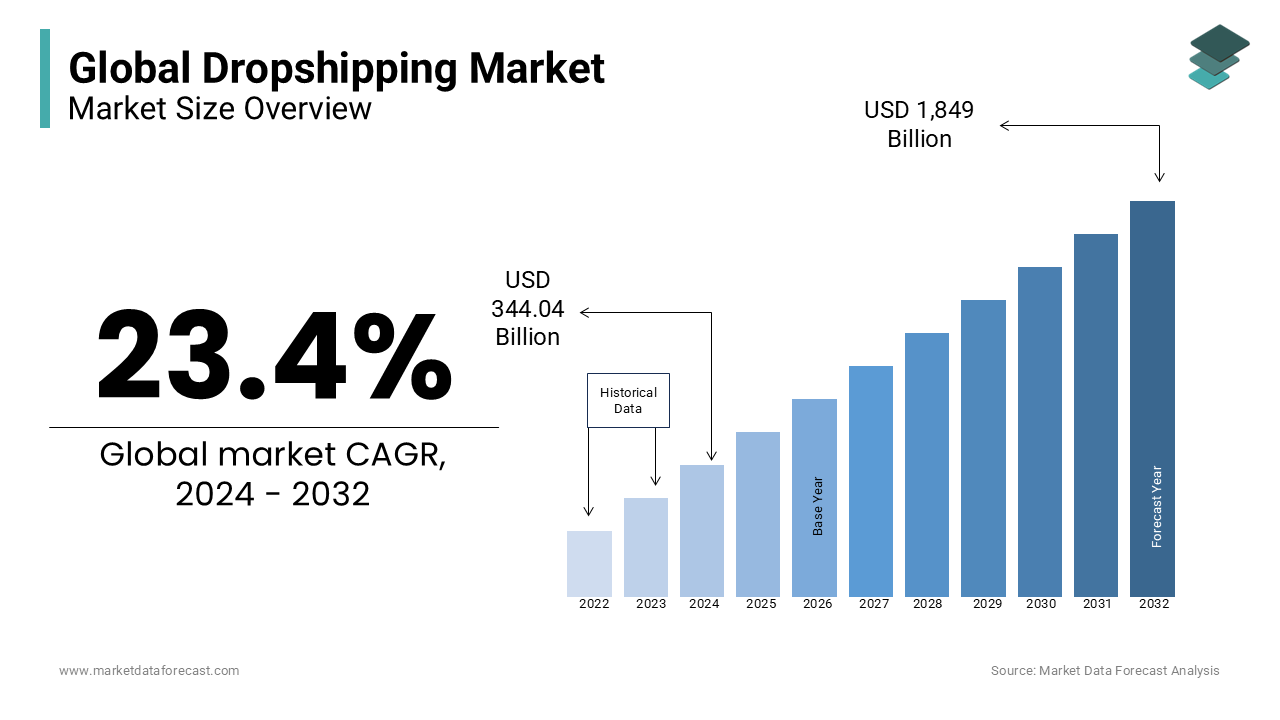
Have you ever wondered how some online sellers run businesses without touching their products?
That's dropshipping – an ecommerce business model that's been gaining serious traction since the rise of platforms like AliExpress in the early 2010s.
Dropshipping is essentially running a store without a stockroom. Instead of buying inventory upfront, you're the middle person between your supplier and your customers. When someone buys from your online store, you forward the order to your supplier, who then ships the product directly to your customer's doorstep.
The beauty of this setup?
You don't need a huge budget to start – no warehouse costs, no boxes of inventory collecting dust in your garage. Instead, you focus on what matters: finding the right products, marketing your store, and keeping your customers happy.
Companies like Wayfair built their empire on this model, and now countless entrepreneurs are following suit. Recent stats show that the dropshipping market is expected to hit $196.78 billion in 2024, proving it's more than a passing trend.
How does dropshipping work?
Dropshipping works like a well-oiled machine, connecting three main players: you (the seller), your supplier, and your customer.
Here's the basic flow:
- You set up an online store and list products from your chosen supplier
- A customer visits your store and places an order
- You forward that order to your supplier and pay the wholesale price
- The supplier packages and ships the product directly to your customer
- You pocket the difference between your retail price and the wholesale cost
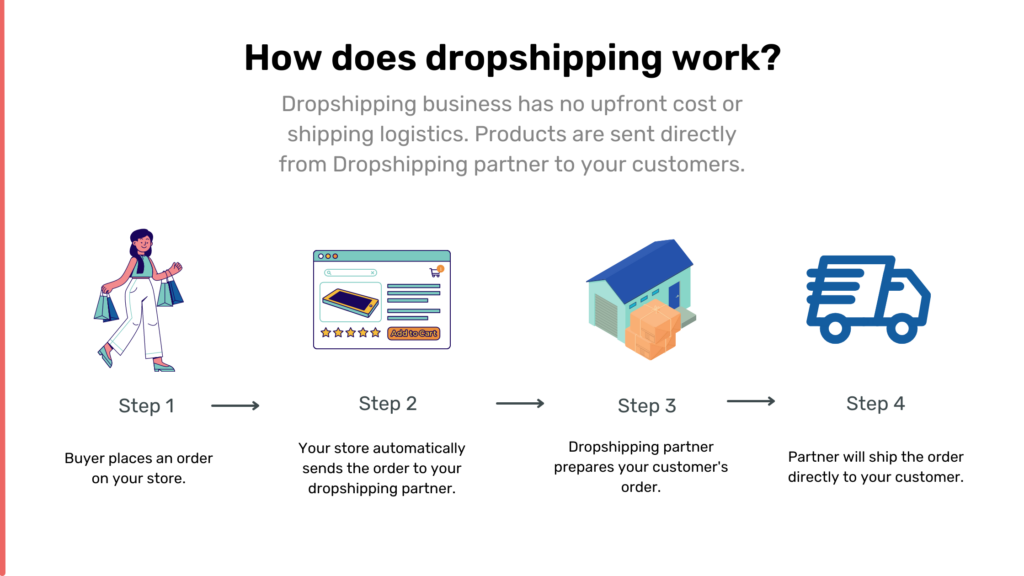
The key differences between traditional ecommerce and dropshipping
Dropshipping and traditional ecommerce represent distinct business models. While both sell products online, they differ fundamentally in inventory management, upfront costs, control, and profit margins.
Business model & operation
The core difference between ecommerce and dropshipping boils down to how each handles the nitty-gritty of running an online store.
Traditional ecommerce is essentially running a digital version of a brick-and-mortar shop. You bet your money upfront on inventory, play warehouse manager with your storage space, and get intimate with packing tape and shipping labels.
Ecommerce gives you complete control —you can ensure product quality, brand, your packaging, and even include those little thank-you notes that customers love.
The flip side? You need to be ready to take on more risk and need more capital to start.
Dropshipping operates more like a virtual middleman. You're the face of the business, but your suppliers do the heavy lifting behind the scenes. When a customer clicks "buy," you forward the order to your supplier, who ships directly to your customer.
No need to worry about storage space or upfront inventory costs – this makes it a lower-risk entry into online selling. But there are trade-offs: you'll typically see smaller profit margins since you're not buying in bulk, and you have less control over shipping times and product quality.
Plus, if your supplier messes up, guess who gets the angry customer emails?
Initial investment & financial risk
You may need some serious cash upfront to start a traditional ecommerce business. You're looking at thousands (sometimes tens of thousands) to stock inventory, rent storage space, and set up your shipping operation.
Not to mention the ongoing costs of staff, packaging materials, and replacing inventory before it runs out. It's a bigger financial gamble, but like most investments, higher risk can mean higher reward. Since you're buying in bulk, each sale typically puts more money in your pocket.
On the other hand, you can get started dropshipping with just enough money to build your website and run some ads – often just a few hundred bucks.
There's no need to max out your credit cards on inventory that might not sell, and you won't wake up in cold sweats worrying about unsold stock gathering dust. This low barrier to entry makes it particularly attractive for first-time entrepreneurs or those testing new product ideas.
But here's the catch – while dropshipping is cheaper to start, it can be tricky to make profitable. Your margins are usually thinner since you pay near-retail prices for each item.
Plus, with lower startup costs comes more competition. That's why successful dropshippers often focus heavily on marketing and try to find unique product niches to stand out from the crowd.
Product selection & market testing
As an ecommerce retailer, product selection can feel a bit like gambling – but with higher stakes. You're putting real money on the line, ordering inventory before you know if it'll sell.
Want to test five different products? Be ready to buy minimum quantities of each (hello, storage space!).
The upside is you can physically inspect your products, maybe even improve them based on customer feedback, and build a unique brand. Plus, you can negotiate better prices with suppliers and protect your profit margins once you find a winner.
Dropshipping is more like a testing playground. Since you don’t buy inventory upfront, you can experiment with dozens of products. Not sure if light-up dog collars will sell?
List them on your store and find out! If they flop, no worries – just remove them and try something else.
You can pivot quickly based on market trends or seasonal changes. Fashion Nova started out as a small local store doing basic clothing dropshipping. They had a limited social media presence and focused mainly on club wear.
As the brand grew, it pivoted to create its own designs and expanded into men's wear, plus sizes, and accessories. They even worked with influencers like Cardi B! It soon became one of the most searched fashion brands online.

However, this flexibility comes with a catch: you're often selling the same products as other dropshippers, which can lead to fierce price competition. And while it's easier to test products, you're limited to what your suppliers offer – customization or product improvements aren't really an option.
- Best ecommerce business ideas to start today
- Best dropshipping products you can start selling right now
Branding and customization
When you run your own ecommerce store, you can add personal touches everywhere: custom packaging, handwritten thank-you notes, branded inserts, or even special product modifications. You're the boss of how your products look and feel.
Take Beardbrand, started by Eric Bandholz in Texas. The men's grooming products brand is known for its super personal approach. This includes handwritten thank-you notes with orders, small product samples so customers can try new items, and packaging with a distinct urban woodsman vibe with custom kraft boxes.

Dropshipping?
That's a different story. Since products ship directly from your supplier to your customer, you're pretty limited in the personalization department. Your products often arrive in generic packaging, sometimes even with your supplier's branding (yikes!).
Some dropshippers get around this by working with suppliers who offer white-label services or custom packaging, but it usually costs extra and isn't always reliable.
- How to find dropshipping suppliers: 7 proven methods
- AliExpress alternatives for your online business
Shipping and fulfillment
Imagine your garage turned into a mini-warehouse, with shelves stacked with inventory and a dedicated packing station. That’s what shipping and fulfillment look like from a traditional ecommerce point of view.
Every time an order comes in, you have to physically pick the product, wrap it carefully, and slap on a shipping label. You control every detail – from the fancy tissue paper to the thank-you notes, and even which shipping carrier to use.
Alternatively, you can look into other ecommerce fulfillment options, like FBA or 3PL. With these options you still own the stock, you just don't send it yourself.
Dropshipping is a whole different ball game.
When a customer clicks 'buy', you simply forward the order to your supplier, who ships it directly to your customer – you never even see the product. Thanks to dropshipping, Ben Francis, founder of Gymshark could start his clothing brand from his bedroom!
The real problems with dropshipping are when things go wrong.
Shipping delays?
You’ll likely hear about it much later because it’s being handled by your supplier. Product delivered looks nothing like the photos? You're caught between an upset customer and a supplier who's not exactly rushing to fix the problem.
Control & quality assurance
When it comes to control and quality assurance, traditional ecommerce and dropshipping are worlds apart. With ecommerce, you're the quality control boss. Every product passes through your hands, letting you catch any defects before they reach customers.
Want to include premium packaging or add a handwritten note? Go for it. Shipping taking too long? Switch carriers. Got a rush order? You can prioritize it.
This hands-on approach means you're building customer trust with every perfectly packaged order that arrives on time.
Dropshipping, though, requires a leap of faith. Since products ship directly from suppliers, you're putting your brand reputation in someone else's hands. Quality control is more about carefully vetting suppliers and constant monitoring than physical inspection.
Profit margins & pricing strategy
Profit margins are a game of numbers, and the rules are pretty different for ecommerce versus dropshipping. With traditional ecommerce, you're playing the bulk-buying game.
By ordering hundreds or thousands of units upfront, you might snag products at $5 that retail for $30 – a healthy 83% margin before other costs. Plus, you can negotiate better rates with suppliers as your volume grows. And, having control over your inventory means you can run flash sales or bundle deals without checking with anyone else.
Dropshipping typically means slimmer pickings in the profit department. Since you're buying products one at a time at higher prices, your margins might be more like 10-30%. If your supplier sells an item for $15 and the market price is $20, you're looking at a $5 profit before factoring in marketing costs and fees.
This means you've got to be extra savvy with your pricing strategy – maybe focusing on high-ticket items or building value through stellar marketing and customer service.
Here's the kicker though: lower margins don't always mean lower profits. Since dropshipping requires less overhead (no warehouse costs, no inventory risk), you might actually pocket more cash at the end of the day.
Scalability & growth potential
With traditional ecommerce, buying in bulk gives you better margins (we're talking potential profits of 50% or higher on each sale). This extra cushion means you can play around with pricing strategies, run killer sales without eating into your profits too much, and invest more in growth.
Since you control inventory, you can spot trends and scale up popular products quickly. This means that ultimately, ecommerce business models are likely to be able to scale and grow bigger than your typical dropshipping business - if done right.
But, growing means more warehouse space, more staff, and more upfront cash for inventory - it's a lot harder to manage.
Geographic reach & market entry
Traditional ecommerce businesses typically start by serving local or regional markets due to practical shipping constraints and inventory management. A seller in New York might focus on the East Coast first to keep shipping costs reasonable and delivery times quick.
A gradual expansion strategy allows for better quality control and customer service but can limit initial market reach.
Dropshipping, however, lets you think globally from day one. Since your suppliers handle shipping, you can work with multiple fulfillment centers worldwide. For example, you could use suppliers in China for Asian customers, and European warehouses for EU buyers, all while sitting at your desk in Australia.
This flexibility makes market entry significantly easier and less risky.
Ecommerce businesses often need substantial resources to expand into new regions – think warehouses and distribution networks. Dropshippers can test new markets with minimal risk, by quickly pivoting their product selection or target audience based on performance data.
Competition
With ecommerce, you often compete based on unique products, brand value, and quality control – things you can manage since you handle the inventory. While competition exists, having your own products or unique sourcing relationships can help you stand out.
Dropshipping, however, is like playing in a much more crowded pool. Since anyone can start with minimal investment, and most dropshippers use the same suppliers (often AliExpress), you'll find tons of stores selling identical products.
This leads to intense price wars and makes it harder to differentiate yourself. The real battle in dropshipping comes down to marketing skills, customer service, and how well you can build a brand around products that others can easily copy.
Which is best, traditional ecommerce or dropshipping?
The choice between traditional ecommerce and dropshipping comes down to your budget and the amount of time you have to dedicate to your business.
Ecommerce is best for you if you have a larger budget and more time to focus on sourcing and managing inventory and fulfillment.
Dropshipping is right for you if you have less budget and are happy to have less control over the product and shipping,
Ready to take the leap and start selling online?
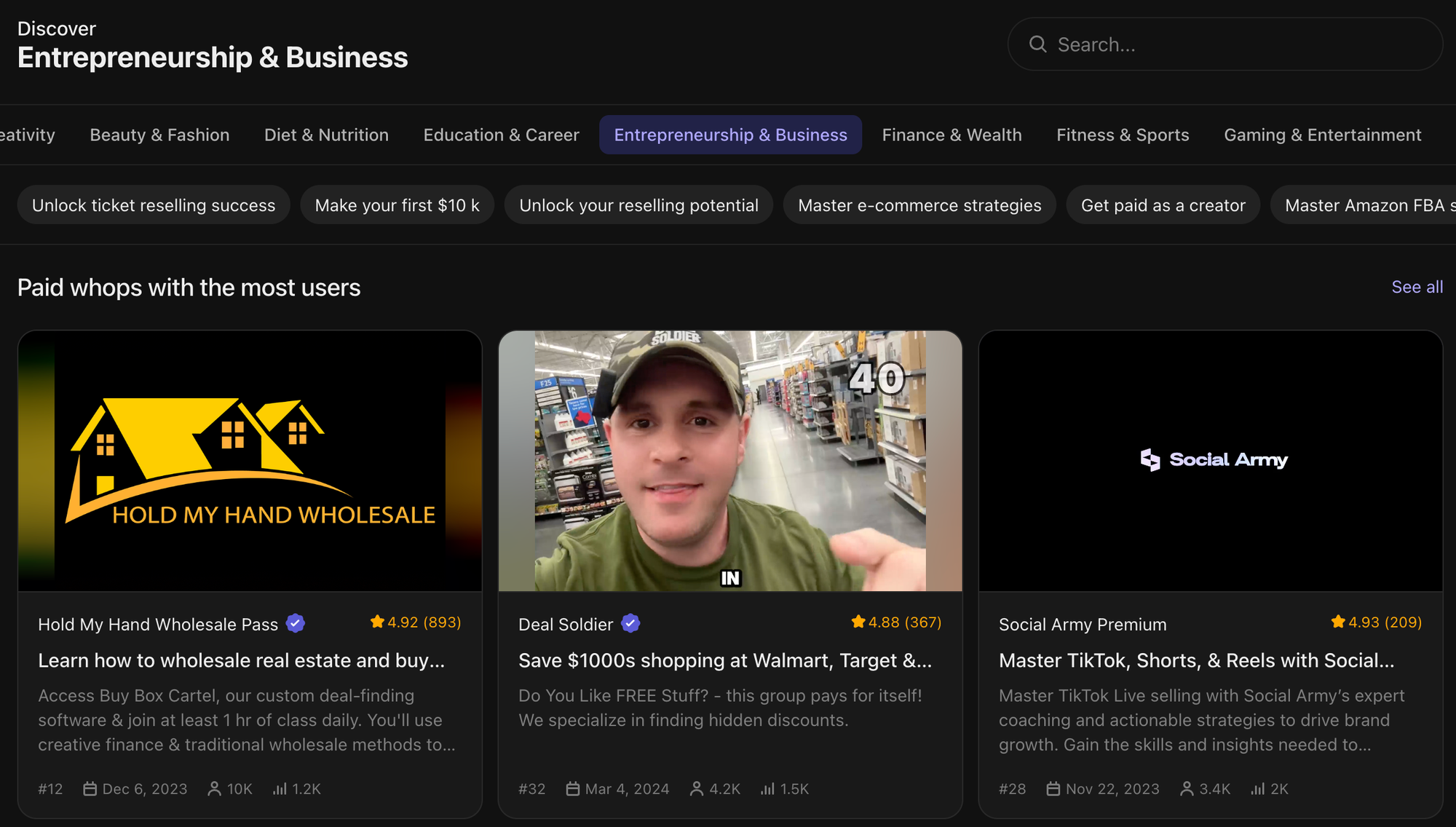
Whether you're heading towards traditional ecommerce or dropshipping, the best way to launch and grow is by following in the footsteps of those who have already built successful businesses.
That's where Whop comes in.
Whop is your partner in success. Our platform is home to thousands of communities and courses focused on ecommerce, including dropshipping. Within these groups you get access to ecommerce and dropshipping experts, and exclusive courses to refine your skills.
Find your whop today and get the help you need to build your business.
FAQs
Still have questions? Here’s everything (else) you need to know about the ecommerce business vs dropshipping.
What is a dropshipper?
A dropshipper is a business owner who sells products without holding inventory. They partner with suppliers who handle storage and ship directly to customers. When a customer places an order, the dropshipper purchases the item from the supplier, who then ships it to the buyer.
What does dropshipping mean?
Dropshipping is a retail business model where sellers don't keep inventory. Instead, when a customer places an order, the seller purchases the item from a third-party supplier who ships it directly to the customer. This minimizes upfront costs and inventory risks for the seller.
Which is more profitable, a traditional ecommerce business or dropshipping?
Running your own online store (ecommerce) can make more money per sale, but you'll need cash upfront for inventory. Dropshipping is cheaper to start since you don't buy products first, but you'll make less per sale. Both can work - it's all about picking good products and getting them in front of buyers.



